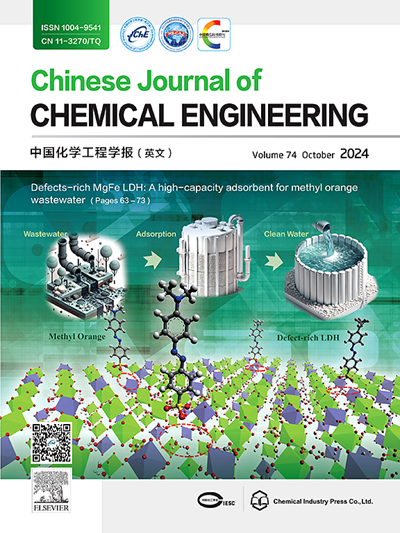环丙沙星在(Zn-Al) LDHs修饰的3D还原氧化石墨烯上的吸附:响应面方法、吸附平衡、动力学和热力学研究
IF 3.7
3区 工程技术
Q2 ENGINEERING, CHEMICAL
引用次数: 0
摘要
环丙沙星(CIP)的滥用和处置导致其在全球水体中被检出,给公众健康和水环境带来巨大风险。本文通过一锅水热法合成了(Zn-Al) LDHs修饰的3D还原氧化石墨烯纳米复合材料((Zn-Al) LDHs/3D- rgo)。在3D-rGO表面高度分布的(Zn-Al) LDHs薄片赋予了所得的(Zn-Al) LDHs/3D-rGO具有优异的CIP吸附性能。吸附结果表明,用Temkin等温模型和拟二级动力学模型可以很好地解释吸附过程。在响应面法优化的条件下,CIP的最大吸附量为20.01 mg·g−1。探讨了共存离子对CIP吸附的抑制作用。吸附机理可能归因于π−π相互作用、氢键、静电和表面络合作用。再生试验表明,所制备的三维多孔材料具有明显的可回收性。所得的(Zn-Al) LDHs/3D-rGO具有去除实际废水中CIP的巨大潜力。本文章由计算机程序翻译,如有差异,请以英文原文为准。
Adsorption of ciprofloxacin on (Zn-Al) LDHs modified 3D reduced graphene oxide: Response surface methodology, adsorption equilibrium, kinetic and thermodynamic studies
The indiscriminate use and disposal of ciprofloxacin (CIP) have led to its detection in water globally, which pose a huge risk to public health and water environment. Herein, (Zn-Al) LDHs modified 3D reduced graphene oxide nanocomposite ((Zn-Al) LDHs/3D-rGO) was synthesized through a feasible one-pot hydrothermal method for CIP removal. The highly distributed (Zn-Al) LDHs flakes on the surface of 3D-rGO endow the resulted (Zn-Al) LDHs/3D-rGO with an excellent adsorption performance for CIP. The adsorption results showed that the adsorption process could be well interpreted by Temkin isothermal model and the pseudo second-order kinetics model. The maximal adsorption capacity of 20.01 mg·g−1 for CIP could be achieved under the optimal conditions optimized by response surface methodology (RSM). The inhibitory effect of co-existing ions on CIP adsorption were also discussed. The probable adsorption mechanism might be ascribed to π−π interactions, hydrogen bonding, electrostatic, and surface complexation. Regeneration tests showed that the obtained 3D porous material also possessed pronounced recyclability. The obtained (Zn-Al) LDHs/3D-rGO holds a great potential for removal of CIP from actual wastewater.
求助全文
通过发布文献求助,成功后即可免费获取论文全文。
去求助
来源期刊

Chinese Journal of Chemical Engineering
工程技术-工程:化工
CiteScore
6.60
自引率
5.30%
发文量
4309
审稿时长
31 days
期刊介绍:
The Chinese Journal of Chemical Engineering (Monthly, started in 1982) is the official journal of the Chemical Industry and Engineering Society of China and published by the Chemical Industry Press Co. Ltd. The aim of the journal is to develop the international exchange of scientific and technical information in the field of chemical engineering. It publishes original research papers that cover the major advancements and achievements in chemical engineering in China as well as some articles from overseas contributors.
The topics of journal include chemical engineering, chemical technology, biochemical engineering, energy and environmental engineering and other relevant fields. Papers are published on the basis of their relevance to theoretical research, practical application or potential uses in the industry as Research Papers, Communications, Reviews and Perspectives. Prominent domestic and overseas chemical experts and scholars have been invited to form an International Advisory Board and the Editorial Committee. It enjoys recognition among Chinese academia and industry as a reliable source of information of what is going on in chemical engineering research, both domestic and abroad.
 求助内容:
求助内容: 应助结果提醒方式:
应助结果提醒方式:


